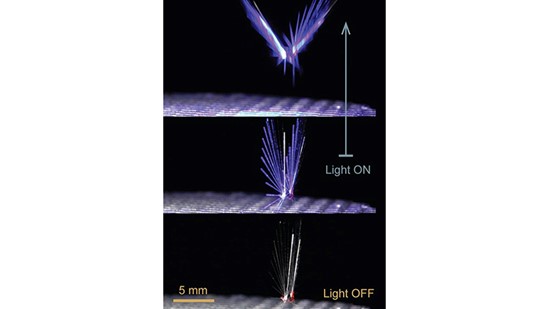Light-controlled flying ‘fairy’ robot could be adapted for artificial pollination
Professional Engineering

A laser beam or LED light can change the shape of the dandelion seed-like structure, controlling how it moves in flight (Credit: Jianfeng Yang/ Tampere University)
A tiny flying device can be controlled by light thanks to stimuli-responsive materials, its creators have said.
Known as the Fairy, the device was developed at Tampere University in Finland. It could one day be adapted for artificial pollination, according to research leader Hao Zeng.
“The development of stimuli-responsive polymers has brought about a wealth of material related opportunities for next generation, small-scale, wirelessly controlled soft bodied robots. For some time now, engineers have known how to use these materials to make small robots that can walk, swim and jump. So far, no-one has been able to make them fly,” a research announcement said.
Zeng and doctoral researcher Jianfeng Yang set out to tackle that with the Fairy, a polymer-assembly device that is carried by air currents and controlled by light.
“This artificial seed is equipped with a soft actuator. The actuator is made of light-responsive liquid crystalline elastomer, which induces opening or closing actions of the bristles upon visible light excitation,” said Zeng.
A laser beam or LED light can change the shape of the dandelion seed-like structure, controlling how it moves in flight and during take-off and landing. “This shape-morphing enables manual tuning of terminal velocity, drag coefficient, and wind threshold for dispersal,” the researchers wrote in an article in Advanced Science.
Like dandelion seeds, the devices generate separated vortex rings as air moves through them, keeping them floating for longer.
The researchers now plan to improve the material’s sensitivity to enable operation in sunlight, as well as scaling up the structures to carry micro-electronic devices such as GPS sensors, or biochemical compounds.
“It sounds like science fiction, but the proof-of-concept experiments included in our research show that the robot we have developed provides an important step towards realistic applications suitable for artificial pollination,” said Zeng.
In the future, millions of artificial pollen-carrying ‘dandelion seeds’ could be dispersed by the wind and then steered by light toward specific areas with trees awaiting pollination, the researchers said.
“This would have a huge impact on agriculture globally, since the loss of pollinators due to global warming has become a serious threat to biodiversity and food production,” said Zeng.
“Many problems” need to be solved first however, the researchers said. Challenges include controlling the landing spot in a precise way, and making the devices reusable and biodegradable. The researchers will collaborate with material scientists and microrobotic researchers to tackle the challenges.
The Fairy project started in September 2021 and will run until August 2026.
We are here to share current happenings in the bee industry. Bee Culture gathers and shares articles published by outside sources. For more information about this specific article, please visit the original publish source: Light-controlled flying ‘fairy’ robot could be adapted for artificial pollination (imeche.org)








